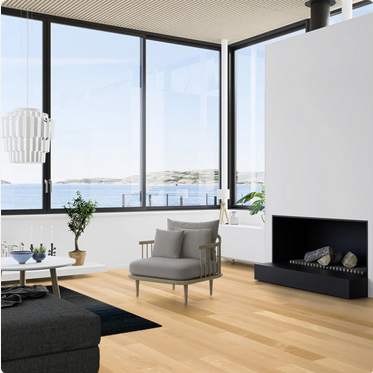
Author, Written by: Bledy (Installation Expert and Technical Writer)
UK homeowners and interior designers are increasingly looking beyond the straight lines of traditional flooring. Curved flooring layouts are emerging as a bold and artistic way to define interiors, especially in contemporary homes and design forward renovations. From soft arcs in open plan living spaces to sweeping transitions between rooms, this design trend is bringing movement and fluidity to modern British homes.
What Are Curved Flooring Layouts?
Curved flooring layouts involve the intentional use of rounded edges, circular insets, or sweeping curves in the way flooring is laid. Unlike the standard grid or linear plank formats, these designs break symmetry and create visual interest. They often combine contrasting materials, such as wood flowing into tile or vinyl meeting stone in a smooth arc.
This approach is about blending spaces rather than dividing them. Whether subtle or dramatic, curves soften the look of a room and make the flooring feel more integrated with the home’s overall layout.
Why Are UK Designers Embracing the Curve?
-
Organic Aesthetic: British design has always leaned toward craftsmanship and detail. Curved layouts echo the natural world and provide a softer, more organic alternative to rigid geometry. They’re perfect for biophilic design schemes and earthy palettes.
-
Zoning in Open Spaces: In many modern UK homes and flats, open-plan layouts are popular. Curved flooring helps define zones without needing walls. For example, a curve can separate a kitchen from a dining area using different textures or tones.
-
Maximising Flow: Particularly in period homes or awkwardly shaped rooms, curves guide the eye and movement through a space. They can be used to draw attention to architectural features or to make transitions between rooms feel more seamless.
-
Unique Visual Appeal: At a time when homeowners are seeking ways to personalise their interiors, curved floors offer a striking focal point. Whether it’s a swirl pattern at an entryway or an arc that wraps around a kitchen island, these layouts make a lasting impression.
Materials That Work Well with Curves
-
Engineered Wood: With its stable construction and versatile formats, engineered wood can be cut and shaped to accommodate curved designs without warping.
-
Luxury Vinyl Tiles (LVT): Flexible, durable, and available in a range of textures, LVT is ideal for curved transitions between rooms, especially when mimicking stone or wood.
-
Polished Concrete or Resin: These materials can be poured in flowing shapes and are commonly used in high end UK homes with a contemporary industrial style.
-
Large Format Porcelain Tiles: When used creatively, tiles can form curved borders or inlays, especially in hallways, bathrooms, or kitchens.
Key Design Tips
-
Work With a Specialist: Curved flooring layouts require precision, so it is essential to work with an installer who has experience in custom layouts.
-
Keep Transitions Natural: When mixing materials, ensure the tones and textures complement each other. A curved oak border flowing into soft grey tiles, for example, can feel cohesive rather than forced.
-
Use Lighting to Highlight Curves: Strategically placed lighting, such as track lights or LED strips, can enhance the curvature and add depth to the flooring.
Where to Use Curved Flooring
-
Hallways and Entrances: Create an inviting path that leads visitors through your home.
-
Open Plan Living Areas: Distinguish the lounge from the kitchen or dining space.
-
Bathrooms and Wet Rooms: Add elegance and softness to tiled areas.
-
Home Offices or Nooks: Define corners or feature areas without rigid borders.
In Closing
Curved flooring layouts are more than just a trend they are a design evolution that embraces movement, creativity, and harmony. For UK homeowners seeking something distinctive, yet timeless, incorporating curves into your flooring could be the next step toward a truly personalised space. Whether you're updating a single room or planning a full renovation, this design direction offers plenty of flexibility and visual impact.
About Author:
Bledy is a flooring installation expert with over 15 years of experience. He writes easy to follow guides and tips to help homeowners and professionals with flooring projects.
